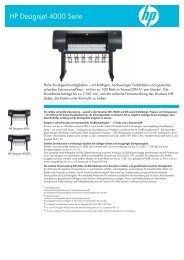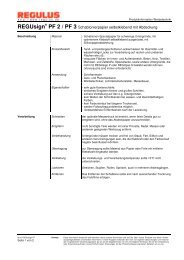STOCHASTIC HALFTONE SCREENING
STOCHASTIC HALFTONE SCREENING
STOCHASTIC HALFTONE SCREENING
You also want an ePaper? Increase the reach of your titles
YUMPU automatically turns print PDFs into web optimized ePapers that Google loves.
C G T T E C H N I C A L P U B L I C A T I O N S<br />
application can be successfully imaged on<br />
230, 245, 255, 265, N272, 280, N300,<br />
305, 330, 355, N366, N380, 390, 420,<br />
and 465. The only limitation will be in a<br />
slight increase in dot gain on the lower<br />
meshes. For mesh counts 280 and above,<br />
there will be no appreciable differences.<br />
This is good news for solvent and<br />
waterbased graphics printers. This remarkable<br />
range of meshes is the result of having<br />
only one size dot to contend with.<br />
Vacuum contact for FM is critical. With<br />
only one dot size, perfect contact is<br />
essential. Any undercutting of the image<br />
will have serious effects on the quality of<br />
the image. Unlike conventional halftones,<br />
where undercutting starts in the highlight<br />
areas and spreads toward the midtones,<br />
FM halftone dots must be considered to be<br />
all highlight in size. This means that<br />
undercutting will affect the entire tone<br />
range of the image, not just the lightest<br />
portions.<br />
Carefully inspect your vacuum frame for<br />
good seals and good even draw down.<br />
Make a test image with 10% halftone dots<br />
of whatever line count you are currently<br />
using. Place nine of these images in your<br />
frame in a 3” x 3” grid to make sure that<br />
exposure and vacuum are even. After<br />
exposure and development, print the<br />
screen and measure the resulting test areas<br />
with a densitometer to be sure that all<br />
areas of your frame are working properly.<br />
With stochastic images, uneven vacuum<br />
can have catastrophic effects on your print<br />
quality. Common items that cause unevenness<br />
are localized seal of the inlet line to<br />
the glass, insufficient bleeder lines, weak<br />
vacuum, broken vacuum beading, and<br />
holes in the vacuum blanket.<br />
The surface of the vacuum glass must<br />
also be in very good condition. Since the<br />
halftone dot is smaller and of only one<br />
size, it is much more sensitive to dirt,<br />
scratches, emulsions, water marks, and<br />
other surface flaws. Defects in the imaged<br />
screen are much more difficult to touch up<br />
after development. If your glass is<br />
scratched, you can get extra life out of it<br />
by flipping it in the frame. With scratches<br />
on the outside of the frame, there is little<br />
problem. The light will refract around<br />
them and the shadow that is cast onto the<br />
positive surface will have little effect on<br />
the exposure and image quality. Screen<br />
makers will have to be even more diligent<br />
in the future to avoid scratching and<br />
nicking the glass.<br />
Cleanliness in the screen area is also very<br />
critical. Dust and small blobs of dirt, ink,<br />
emulsion, tape adhesive, etc. are all very<br />
critical to the image. Because the FM<br />
halftones are all one size, and smaller than<br />
conventional halftone dots, any dirt is a<br />
bigger problem than you may be used to.<br />
Static build-up on the positives and<br />
vacuum glass attract and hold dust and<br />
dirt. Careful attention to cleaning the glass<br />
after every exposure will help to guarantee<br />
successful results. Anti-static sprays and<br />
coatings are a good idea to help in reducing<br />
the build-up of static. Wiping each<br />
positive with anti-static film cleaner also<br />
helps. Don’t overlook the vacuum blanket<br />
as a source of contamination.<br />
Exposure of film positives is also somewhat<br />
different than conventional halftones.<br />
Because the dots are all one size, the<br />
exposure latitude is significantly larger.<br />
We recently conducted tests with 100<br />
micron dots (similar to 65 line halftone<br />
dots), and were able to achieve a 100%<br />
variation in our exposure with no negative<br />
loss of dots between 3% and 97%. For<br />
instance, if a normal exposure would be<br />
60 units, your acceptable latitude with FM<br />
would be 120 units. You do not have<br />
partial undercutting of the image. It will<br />
either all be there or it will all be gone.<br />
This is particularly important in maintaining<br />
fine highlight detail. It is very easy to<br />
maintain 1%-2% tone in light pastel areas.<br />
TECH LIBRARY<br />
ONLINE<br />
TECHNICAL<br />
SUPPORT<br />
©1994 Coudray Graphic Technologies :: 805.541.1521 <strong>STOCHASTIC</strong> <strong>HALFTONE</strong> <strong>SCREENING</strong><br />
7
















